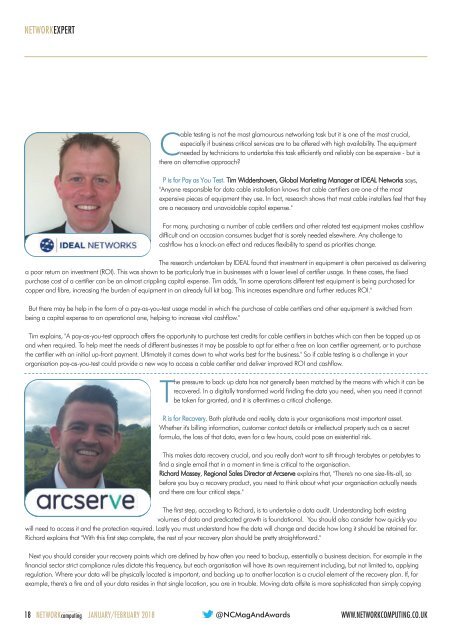NC1801
You also want an ePaper? Increase the reach of your titles
YUMPU automatically turns print PDFs into web optimized ePapers that Google loves.
NETWORKEXPERT<br />
Cable testing is not the most glamourous networking task but it is one of the most crucial,<br />
especially if business critical services are to be offered with high availability. The equipment<br />
needed by technicians to undertake this task efficiently and reliably can be expensive - but is<br />
there an alternative approach?<br />
P is for Pay as You Test. Tim Widdershoven, Global Marketing Manager at IDEAL Networks says,<br />
"Anyone responsible for data cable installation knows that cable certifiers are one of the most<br />
expensive pieces of equipment they use. In fact, research shows that most cable installers feel that they<br />
are a necessary and unavoidable capital expense."<br />
For many, purchasing a number of cable certifiers and other related test equipment makes cashflow<br />
difficult and on occasion consumes budget that is sorely needed elsewhere. Any challenge to<br />
cashflow has a knock-on effect and reduces flexibility to spend as priorities change.<br />
The research undertaken by IDEAL found that investment in equipment is often perceived as delivering<br />
a poor return on investment (ROI). This was shown to be particularly true in businesses with a lower level of certifier usage. In these cases, the fixed<br />
purchase cost of a certifier can be an almost crippling capital expense. Tim adds, "In some operations different test equipment is being purchased for<br />
copper and fibre, increasing the burden of equipment in an already full kit bag. This increases expenditure and further reduces ROI."<br />
But there may be help in the form of a pay-as-you-test usage model in which the purchase of cable certifiers and other equipment is switched from<br />
being a capital expense to an operational one, helping to increase vital cashflow."<br />
Tim explains, "A pay-as-you-test approach offers the opportunity to purchase test credits for cable certifiers in batches which can then be topped up as<br />
and when required. To help meet the needs of different businesses it may be possible to opt for either a free on loan certifier agreement, or to purchase<br />
the certifier with an initial up-front payment. Ultimately it comes down to what works best for the business." So if cable testing is a challenge in your<br />
organisation pay-as-you-test could provide a new way to access a cable certifier and deliver improved ROI and cashflow.<br />
The pressure to back up data has not generally been matched by the means with which it can be<br />
recovered. In a digitally transformed world finding the data you need, when you need it cannot<br />
be taken for granted, and it is oftentimes a critical challenge.<br />
R is for Recovery. Both platitude and reality, data is your organisations most important asset.<br />
Whether it's billing information, customer contact details or intellectual property such as a secret<br />
formula, the loss of that data, even for a few hours, could pose an existential risk.<br />
This makes data recovery crucial, and you really don't want to sift through terabytes or petabytes to<br />
find a single email that in a moment in time is critical to the organisation.<br />
Richard Massey, Regional Sales Director at Arcserve explains that, "There's no one size-fits-all, so<br />
before you buy a recovery product, you need to think about what your organisation actually needs<br />
and there are four critical steps."<br />
The first step, according to Richard, is to undertake a data audit. Understanding both existing<br />
volumes of data and predicated growth is foundational. You should also consider how quickly you<br />
will need to access it and the protection required. Lastly you must understand how the data will change and decide how long it should be retained for.<br />
Richard explains that "With this first step complete, the rest of your recovery plan should be pretty straightforward."<br />
Next you should consider your recovery points which are defined by how often you need to backup, essentially a business decision. For example in the<br />
financial sector strict compliance rules dictate this frequency, but each organisation will have its own requirement including, but not limited to, applying<br />
regulation. Where your data will be physically located is important, and backing up to another location is a crucial element of the recovery plan. If, for<br />
example, there's a fire and all your data resides in that single location, you are in trouble. Moving data offsite is more sophisticated than simply copying<br />
18 NETWORKcomputing JANUARY/FEBRUARY 2018 @NCMagAndAwards<br />
WWW.NETWORKCOMPUTING.CO.UK

















